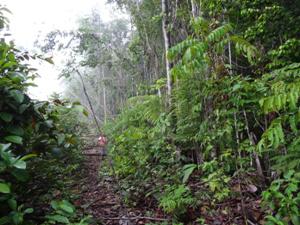Alci Albiero Junior
Evaluate spatio-temporally forest fragmentation and edge effect in four Amazon tree species from different successional groups through dendrochronology technical.

© Rob Bierregaard
The fragmentation of the Amazon Rainforest, the increased mortality of trees and their replacement with fast growing species are promoting a carbon collapse, reducing their permanence time in one of the biggest terrestrial sink. Being urgently the development of projects that reveal how this fragmentation and climate change are affecting the dynamics of growth, biomass accumulation and mortality in trees of the largest rainforest in the world of extreme importance in the global carbon cycle. However, little is known about the cumulative biomass in trees throughout their lives through a dendrochronology perspective.

Forest edge of Dimona reserve (100ha). Biological Dynamics of Forest Fragments Project (BDFFP).
The dendrochronology, science that studies the growth rings of trees, is the main form of analysis of the age, above-ground carbon accumulation and the growth rate of the woody species with annual resolution. Providing new opportunities and perspectives in understanding the earth's carbon cycle.
The increasing dominance of pioneer tree species in fragmented areas and affected by edge effects, alter the dynamics of carbon in these phytophysionomies that, by having a lower density wood and a shorter life, accelerate the release of carbon to the atmosphere, reducing the time residence stored. Thus, the analysis of the dynamics of growth and mortality in different successional categories (pioneer and no pioneer), will indicate which category are storing more carbon over their lives in fragmented areas affected by edge effects. Revealing the homogenization and dominance of pioneer and early trees in these areas is decreasing carbon permanence in these environments.
The aim of this project is evaluate spatio-temporally effect of forest fragmentation and edge effect in four Amazon tree species from different successional groups (pioneer and non-pioneer), through dendrochronology technical, how: (i) the temporal radial and biomass growth in the trunk, (ii) the annual variation of fixed carbon in the wood;(iii) the rate and timing of mortality and (iv) the relationship with climatic data.
The study area is located 80 km north of Manaus/AM/Brazil (2°30'S, 60°W), covering 2,488 ha of forest reserves of ecological interest, that belong to the Biological Dynamics of Forest Fragments Project (BDFFP).
The identification of accumulated biomass in trees throughout their lives will indicate whether forest fragmentation and edge effects in the Brazilian Central Amazon are transforming these species in source of carbon, reducing their ecosystem services. Results that will reveal how the dynamics of carbon in trees of different successional categories is being changed by the reduction of habitats, contributing to climate change.